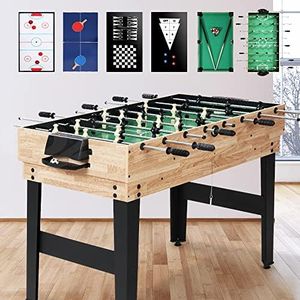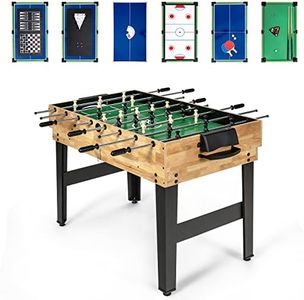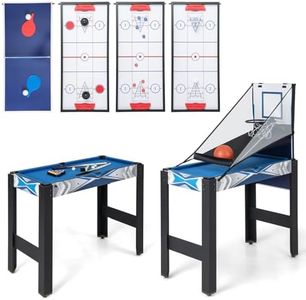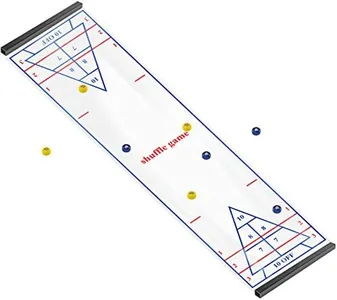We Use CookiesWe use cookies to enhance the security, performance,
functionality and for analytical and promotional activities. By continuing to browse this site you
are agreeing to our privacy policy
5 Best Shuffleboard Tables
From leading brands and best sellers available on the web.By clicking on a link to a third party's website, log data is shared with that third party.
Buying Guide for the Best Shuffleboard Tables
Choosing a shuffleboard table can be a fun experience, especially when you know what to look for. Your main goal should be to find a table that fits well in your space, lasts for years, and gives you the playing experience you want. Think about where you’ll put the table, who will use it, and whether you want something for serious competition or casual fun with family and friends. Paying attention to a few important features will help you end up with a table you’ll enjoy for a long time.Table LengthTable length is the overall measurement from end to end of the playing surface. This matters because longer tables are more challenging and closer to professional standards, while shorter tables are easier to fit in smaller rooms and can be better for casual play. Shuffleboard tables commonly come in lengths from 9 to 22 feet. A 22-foot table is considered tournament size and offers the most authentic experience, but it requires a large space and is best for serious players. Tables around 14 to 16 feet are a nice compromise between space and playability, while tables shorter than this are best for tight spaces and family fun. Think about who will use the table and how much room you have when deciding which length is best for you.
Playing Surface MaterialThe playing surface material is usually made from hardwood or a wood composite and coated with a smooth finish. This is important because it affects how the pucks glide and the overall feel of the game. Top-quality shuffleboard tables use solid hardwood, which is durable and provides a consistent playing experience, while less expensive tables might use MDF or other composites which may not last as long or feel as smooth. If you want a table that lasts and gives a professional feel, look for solid wood surfaces with a thick, glossy finish. If you’re aiming for a family-friendly or more casual game, you can compromise with composite wood, but understand it might need more care and could be less durable over time.
Surface WidthSurface width refers to the width of the actual playing area, not the overall width of the table including rails and gutters. A wider playing surface offers more space for challenging shots and feels more like a professional table, while a narrower surface saves space and is easier for younger or less experienced players. Standard surfaces are generally 16 to 20 inches wide. For a challenge and more authentic play, look for the widest surface your space allows. For smaller or more casual setups, a narrower surface may be more comfortable and help the game move along faster.
Climatic AdjustersClimatic adjusters are devices under the shuffleboard playing surface that allow you to tweak its shape if it warps due to changes in humidity or temperature. This is important because a level, smooth playing surface is key to a good game, and real wood can move with weather changes. If you live in an area with changing humidity or want your surface to stay in top shape, choose a table with climate adjusters so you can easily correct any minor warping. In very stable environments or for light, occasional play, this feature is less necessary but still a nice addition for keeping your table in the best condition.
Scoring SystemThe scoring system on shuffleboard tables can be marked directly onto the playing surface or come as attached or freestanding scoreboards. The most common are the traditional triangular scoring zones, but some tables offer different variants to mix up the game. A clear, easy-to-read system makes it simple to track scores and adds to the friendly competition. If you’re teaching newcomers or want an easy, hassle-free experience, look for well-marked scoring zones or include an additional external scoreboard for convenience.
Table Base and LegsThe base and legs of a shuffleboard table support the playing surface and impact the table’s stability. Heavier, sturdy bases keep the table steady during play, while cheaper or lighter bases might wobble or shift, making the game less fun. Adjustable feet are especially useful if your floor is uneven, helping to keep the table level. If you want a smooth, consistent game every time, aim for a table with solid, heavy bases and leveling features.
Finish and MaintenanceThe finish protects the shuffleboard’s playing surface and affects its speed. A high-quality polyurethane finish offers a durable, low-maintenance surface that keeps the table fast and smooth, while wax or silicone sprays can also be applied regularly to maintain slickness. Choosing a table with a durable finish will save you time on upkeep and provide a better playing experience. Regular cleaning and occasional re-application of approved products will help any table last longer, so consider your willingness to maintain the surface when picking a table.



